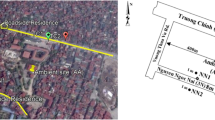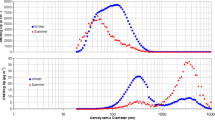Abstract
In epidemiological studies, ultrafine particle (UFP) data from a single monitoring site are generally used as a measure of population exposure potentially resulting in exposure misclassification. From August 2009 to October 2010, 1-week campaigns were conducted during each season. The temporal and spatial variations of UFP number size distributions were investigated at 12 monitoring sites distributed across a 9 × 9 km urban area in Rochester, New York using a Fast Mobility Particle SizerTM spectrometer. The overall average number concentrations of 5.6- to 560-nm particles in summer, winter, spring, and fall were 9,025, 10,939, 4,955, and 14,485 cm−3, respectively. Coefficients of divergence and correlation coefficients were calculated between site pairs to assess the spatial heterogeneity in the particle number size distributions. Moderate spatial divergence and uniform temporal variation were found for the chosen sites. Elevated UFP number concentrations were observed near highways, off-road diesel engines, and residential wood combustion sources, indicating significant contributions to the UFP exposure of people living adjacent to these sources. Our results suggest that one stationary monitoring site may not represent the actual human UFP exposure over a whole urban area.








Similar content being viewed by others
References
Cyrys, J., Pitz, M., Heinrich, J., Wichmann, H. E., & Peters, A. (2008). Spatial and temporal variation of particle number concentration in Augsburg, Germany. Science of the Total Environment, 401, 168–175.
Finlayson-Pitts, B. J., & Pitts, J. N. (1999). Chemistry for upper and lower atmosphere. Theory, experiments, and applications. San Diego, CA: Academic.
Forastiere, F., Stafoggia, M., Picciotto, S., Bellander, T., D’Ippoliti, D., Lanki, T., et al. (2005). A case-crossover analysis of out-of-hospital coronary deaths and air pollution in Rome, Italy. American Journal of Respiratory and Critical Care Medicine, 172, 1549–1555.
Hudda, N., Cheung, K., Moore, K. F., & Sioutas, C. (2010). Inter-community variability in total particle number concentrations in the eastern Los Angeles air basin. Atmospheric Chemistry and Physics Discussion, 10, 13901–13943.
Jeong, C. H., Hopke, P. K., Chalupa, D. C., & Utell, M. J. (2004). Characteristics of nucleation and growth events of ultrafine particles measured in Rochester, NY. Environmental Science and Technology, 38, 1933–1940.
Johnson, T., Caldow, R., Pocher, A., Mirme, A., Kittleson, D. (2004). A new electrical mobility particle sizer spectrometer for engine exhaust particle measurements. Testing and Instrumentation SAE SP-1871.
Kasumba, J., Hopke, P. K., Chalupa, D. C., & Utell, M. J. (2009). Comparison of sources of submicron particle number concentrations measured at two sites in Rochester, NY. Science of the Total Environment, 407, 5071–5084.
Krecl, P., Ström, J., & Johansson, C. (2008). Diurnal variation of atmospheric aerosol during the wood combustion season in Northern Sweden. Atmospheric Environment, 42, 4113–4125.
Krudysz, M., Moore, K., Geller, M., Sioutas, C., & Froines, J. (2009). Intra-community spatial variability of particulate matter size distributions in Southern California/Los Angeles. Atmospheric Chemistry and Physics, 9, 1061–1075.
Lanki, T., Pekkanen, J., Aalto, P., Elosua, R., Berglind, N., D’Ippoliti, D., et al. (2006). Association of traffic related air pollutants with hospitalisation for first acute myocardial infarction: the HEAPSS study. Occupational and Environmental Medicine, 63, 844–851.
Lianou, M., Chalbot, M.-C., Kotronarou, A., Kavouras, I. G., Karakatsani, A., Katsouyanni, K., et al. (2007). Dependence of home outdoor particulate mass and number concentrations on residential and traffic features in urban areas. Journal of the Air & Waste Management Association, 57, 1507–1517.
Mejia, J. F., Morawska, L., & Mengersen, K. (2008). Spatial variation in particle number size distributions in a large metropolitan area. Atmospheric Chemistry and Physics, 8, 1127–1138.
Moore, K., Krudysz, M., Pakbin, P., Hudda, N., & Sioutas, C. (2009). Intra-community variability in total particle number concentrations in the San Pedro harbor area (Los Angeles, California). Aerosol Science and Technology, 43, 587–603.
Ogulei, D., Hopke, P. K., Chalupa, D. C., & Utell, M. J. (2007a). Modeling source contributions to submicron particle number concentrations measured in Rochester, NY. Aerosol Science and Technology, 41, 179–201.
Ogulei, D., Hopke, P. K., Ferro, A. R., & Jaques, P. A. (2007b). Factor analysis of submicron particle size distributions near a major United States–Canada trade bridge. Journal of the Air & Waste Management Association, 57, 190–203.
Penttinen, P., Timonen, K. L., Tiittanen, P., Mirme, A., Ruuskanen, J., & Pekkanen, J. (1999). Fine and ultrafine particulate matter in ambient air are associated with peak flow decreases in adult asthmatic subjects. American Journal of Respiratory and Critical Care Medicine, 157, A878.
Peters, A., Wichmann, H. E., Tuch, T., Heinrich, J., & Heyder, J. (1997a). Comparison of the number of ultrafine particles and the mass of fine particles with respiratory symptoms in asthmatics. Annals of Occupational Hygiene, 41, 19–23.
Peters, A., Wichmann, H. E., Tuch, T., Heinrich, J., & Heyder, J. (1997b). Respiratory effects are associated with the number of ultra-fine particles. American Journal of Respiratory and Critical Care Medicine, 155, 1376–1383.
Pinto, J. P., Lefohn, A. S., & Shadwick, D. S. (2004). Spatial variability of PM2.5 in urban areas in the United States. Journal of the Air & Waste Management Association, 54, 440–449.
Stolzel, M., Breitner, S., Cyrys, J., Pitz, M., Wolke, G., Kreyling, W., et al. (2007). Daily mortality and particulate matter in different size classes in Erfurt Germany. Journal of Exposure Science and Environmental Epidemiology, 17, 458–467.
U.S. Environmental Protection Agency (USEPA) (2009). Integrated science assessment for particulate matter (Final Report). U.S. Environmental Protection Agency, Washington, DC, EPA/600/R-08/139F.
Wang, Y., Zhu, Y., Salinas, R., Ramirez, D., Karnae, S., & John, K. (2008). Roadside measurements of ultrafine particles at a busy urban intersection. Journal of the Air & Waste Management Association, 58, 1449–1457.
Wang, Y., Hopke, P. K., Chalupa, D. C., & Utell, M. J. (2010a). Long-term study of urban ultrafine particles and other pollutants. Atmospheric Environment. doi:10.1016/j.atmosenv.2010.08.022.
Wang, Y., Huang, J., Zananski, T. J., Hopke, P. K., & Holsen, T. M. (2010b). Impacts of the Canadian forest fires on atmospheric mercury and carbonaceous particles in northern New York. Environmental Science and Technology, 44, 8435–8440.
Wang, Y., Hopke, P. K., Rattigan, O. V., & Zhu, Y. (2011a). Characterization of ambient black carbon and wood burning particles in two urban areas. Journal of Environmental Monitoring, 13, 1919–1926.
Wang, Y., Hopke, P. K., Rattigan, O. V., Xia, X., Chalupa, D. C., & Utell, M. J. (2011b). Characterization of residential wood combustion particles using the two-wavelength aethalometer. Environmental Science and Technology, 45, 7387–7393.
Wichmann, HE., Spix, C., Tuch, T., Woelke, G., Peters, A., Heinrich, J., et al. (2000). Daily mortality and fine and ultrafine particles in Erfurt Germany. Part I: Role of particle number and particle mass. Health Effects Institute (HEI) Research Report 98.
Wilson, J. G., Kingham, S., Pearce, J., & Sturman, A. P. (2005). A review of intraurban variations in particulate air pollution: implications for epidemiological research. Atmospheric Environment, 39, 6444–6462.
Wongphatarakul, V., Friedlander, S. K., & Pinto, J. P. (1998). A comparative study of PM2.5 ambient aerosol chemical databases. Environmental Science and Technology, 32, 3926–3934.
Zhu, Y., Hinds, W. C., Kim, S., Shen, S., & Sioutas, C. (2002a). Study on ultrafine particle and other vehicles pollutants near a major highway with heavy duty diesel traffic. Atmospheric Environment, 36, 4323–4335.
Zhu, Y., Hinds, W. C., Kim, S., & Sioutas, C. (2002b). Concentrations and size distribution of ultrafine particles near a major highway. Journal of the Air & Waste Management Association, 52, 1032–1042.
Acknowledgments
This work was supported by the New York State Energy Research and Development Authority (NYSERDA) through Contracts 8650 and 10604 and the United States Environmental Protection Agency (EPA) through Science to Achieve Results (STAR) Grant RD83107801, a Syracuse Center of Excellence CARTI project award, which is supported by a grant from the U.S. Environmental Protection Agency [award no. X-83232501-0]. Although the research described in this article has been funded in part by the EPA, it has not been subjected to the Agency’s required peer and policy review and, therefore, does not necessarily reflect the views of the Agency and no official endorsement should be inferred.
Author information
Authors and Affiliations
Corresponding author
Additional information
Recent ambient UFP studies using the FMPS, overall COD and r values, wind rose plots, Delta-C values, the average particle size distributions, and references listed in Table S1 are included in the Electronic Supplementary Material.
Electronic Supplementary Material
Below is the link to the electronic supplementary material.
ESM 1
(PDF 1008 kb)
Rights and permissions
About this article
Cite this article
Wang, Y., Hopke, P.K. & Utell, M.J. Urban-Scale Seasonal and Spatial Variability of Ultrafine Particle Number Concentrations. Water Air Soil Pollut 223, 2223–2235 (2012). https://doi.org/10.1007/s11270-011-1018-z
Received:
Accepted:
Published:
Issue Date:
DOI: https://doi.org/10.1007/s11270-011-1018-z




